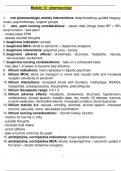Module 10 - pharmacology
1. non pharmacologic anxiety interventions: deep breathing, guided imagery,
music, psychotherapy, support groups
2. -lam, -pam nursing considerations: - asses vitals (drugs lower BP + HR),
renal function - bed alarm
- mostly taken PRN
- assess suicidal thoughts
3. buspirone indication: anxiety
4. buspirone MOA: binds to serotonin + dopamine receptors
5. buspirone interactions: grapefruit juice - toxicity
6. busprione adverse effects: drowsiness, dizziness, headache, nausea,
nervousness, excitement
7. buspirone nursing considerations: - take on a scheduled basis
- may take 1-2 weeks to become fully effective
8. lithium indications: manic episodes in bipolar psychosis
9. lithium MOA: alters ion transport in nerve and muscle cells and increases
receptor sensitivity to serotonin
10. lithium interactions: increased levels with diuretics, methydopa, NSAIDs,
haloperidol, antidepressants, theophylline, phenothiazole
11. lithium therapeutic range: 0.5-1.5
12. lithium adverse effects: headache, drowsiness, dizziness, hypotension,
restlessness, slurred speech, metallic taste, dry mouth, GI distress, tremors,
muscle weakness, hand/ankle edema, increased urination, blood dyscarias
13. lithium toxicity s/s: nausea, vomiting, diarrhea, slurred speech, increased
tremors, seizures, coma, decreased coordination
14. lithium nursing considerations: - monitor kidney function
- monitor for low Na (<145)
- suicidal thoughts
- increase fluid intake
- avoid caffeine
- take w food to minimize GI upset
15. amitriptyline, nortriptyline indications: major/agitated depression
16. amitriptyline, nortriptyline MOA: blocks norepinephrine + serotonin uptake in
the brain + blocks histamine receptors
1/5
, Module 10 - pharmacology
17. amitriptyline, nortriptyline contraindications: MAOIs (14 days), pregnancy,
pt with chronic cardiac/seizure disorders
18. amitriptyline, nortriptyline interactions: - cns dep. + alcohol - increased cns
effects
- MAOIs - cardiotoxicity
- phenothiazine, haloperidol - increased sedation + anticholinergic effects
19. amitriptyline, nortriptyline adverse effects: sedation, dizziness,
anticholinergic, weight gain, GI distress, sexual dysfunction, orthostatic
hypotension, dysrhythmias, blood dyscarias
20. amitriptyline, nortriptyline nursing considerations: - rise in stages - take
at bed time
21. isocarboxazid, tranylcypromine, phenelzine, selegiline (MAO-B, TD
patch) indications: depression not controlled by TCAs or 2nd gen antidepressants
22. isocarboxazid, tranylcypromine, phenelzine, selegiline (MAO-B, TD patch)
MOA: blocks MO enzyme that inactivates norepinephrine, dopamine, epinephrine,
and serotonin
23. isocarboxazid, tranylcypromine, phenelzine, selegiline (MAO-B, TD patch)
interactions: - phenylephrine + pseudo - HTN crisis
- must be off TCA, SSRI, SNRI 14 days before starting med
- tyramine containing foods
24. tyramine containing foods: cheddar, blue, Swiss, sausage, pepperoni, salami,
smoked fish, yeast, red wine, fav a beans 25. isocarboxazid, tranylcypromine,
phenelzine, selegiline (MAO-B, TD patch) adverse effects: agitation,
restlessness, insomnia, anticholinergic, orthostatic hypotension, HTN crisis from
fatal tyramine reaction
26. fluvoxamine, fluoxetine, sertraline, citalopram indications: major
depression, anxiety, OCD, phobias, panic, migraine prevention
27. fluvoxamine, fluoxetine, sertraline, citalopram MOA: block uptake of
serotonin
28. fluvoxamine, fluoxetine, sertraline, citalopram interactions: - cns dep. +
alcohol - increased cns effects
- st johns - increased serotonin syndrome
- grapefruit - toxicity
- MAOIs + SSRIs
2/5




